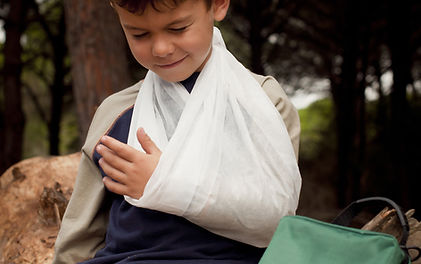
The following are the most common symptoms of a fracture.
You may hear or feel a snap or a grinding noise as the injury happens.
There may be swelling, warmth, bruising, redness, or tenderness around the injured area.
In addition, you may feel faint, dizzy or sick as a result of the shock of breaking a bone.
You may feel pain when you put weight on the injury, touch it, press it, or move it.
The injured part may look deformed, and in severe breaks, the broken bone may break through the skin.
The symptoms of a broken bone may resemble other medical conditions or problems. Always consult your physician for a diagnosis.
A fracture is the medical term for a broken bone. Fractures are common; the average person has two during a lifetime, according to mayoclinic.org
They occur when the physical force exerted on the bone is stronger than the bone itself. There are many types of fractures, but the main categories are displaced, non-displaced, open, and closed. The bone may not break at all, but merely bend, as is the case with greenstick fractures (which are more common in kids).
Displaced and non-displaced fractures refer to the way the bone breaks. In a displaced fracture, the bone snaps into two or more parts and moves so that the two ends are not lined up straight. If the bone is in many pieces, it is called a comminuted fracture. In a non-displaced fracture, the bone cracks either part or all of the way through, but does move and maintains its proper alignment.
A closed fracture is when the bone breaks but there is no puncture or open wound in the skin. An open fracture is one in which the bone breaks through the skin; it may then recede back into the wound and not be visible through the skin. This is an important difference from a closed fracture because with an open fracture there is a risk of a deep bone infection. A simple fracture is a closed non displaced break, or greenstick fracture.
The most commonly broken bones are: the collarbone, arm, wrist, hip, and ankle. Symptoms of a fracture include: swelling or bruising over a bone, deformity of an arm or leg, pain in the injured area that gets worse when the area is moved or pressure is applied, loss of function in the injured area. Swelling may occur quickly, and an x-ray and proper splinting or immobilization can minimize pain and long term effects. Treatment includes rest, ice, compression provided by a splint or ace wrap, and elevation help to decrease pain and speed healing. This is often abbreviated as RICE. Ibuprofen is commonly used to decrease inflammation and relieve pain. Other pain relievers can be prescribed if needed.
If you suspect a broken bone, you may visit Willis Urgent Care where we can perform diagnostic x-rays. We can stabilize, splint, and arrange appropriate specialist.
For more information on broken bones and fractures see the following websites:
https://www.webmd.com/a-to-z-guides/understanding-fractures-basic-information
https://www.emedicinehealth.com/wilderness_fractures_or_dislocations/article_em.htm
Disclaimer: The links above are to sites independent of Willis Urgent Care. The information provided is for educational purposes only, and is not a substitute for professional medical advice, diagnosis, or treatment. If you have or suspect you may have a health problem, you should consult your doctor. Always follow your doctor’s recommendations regarding your specific medical questions, treatments, therapies, and other needs.



